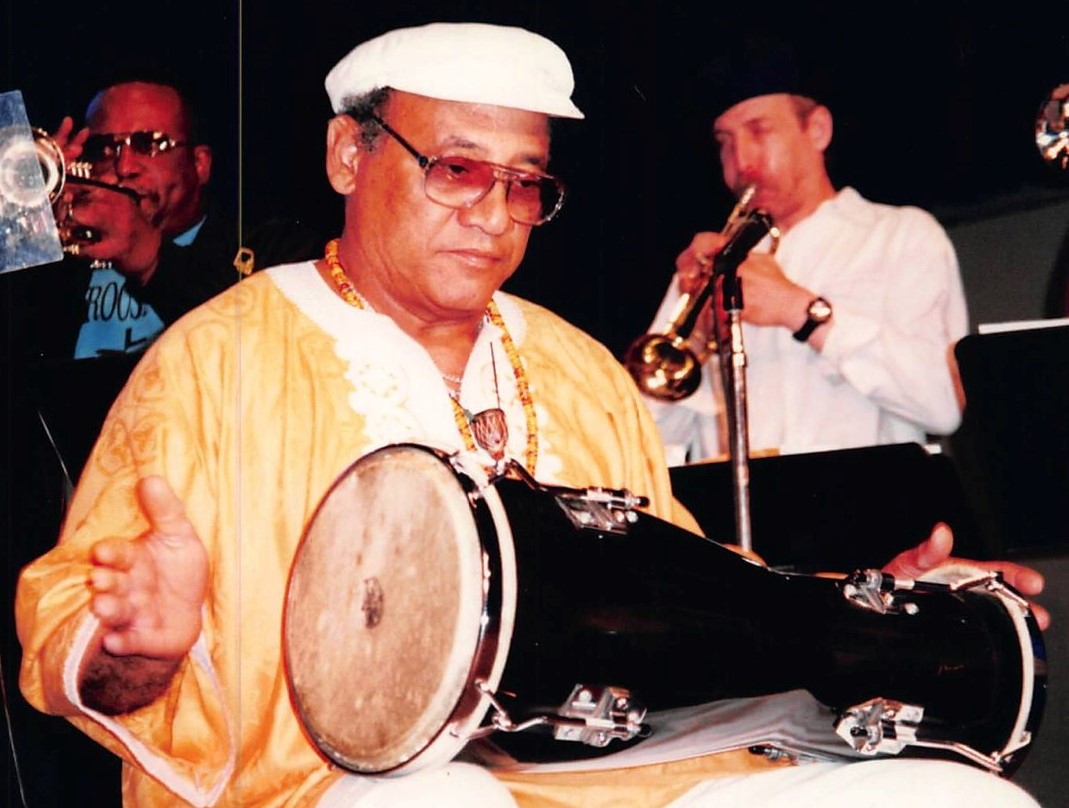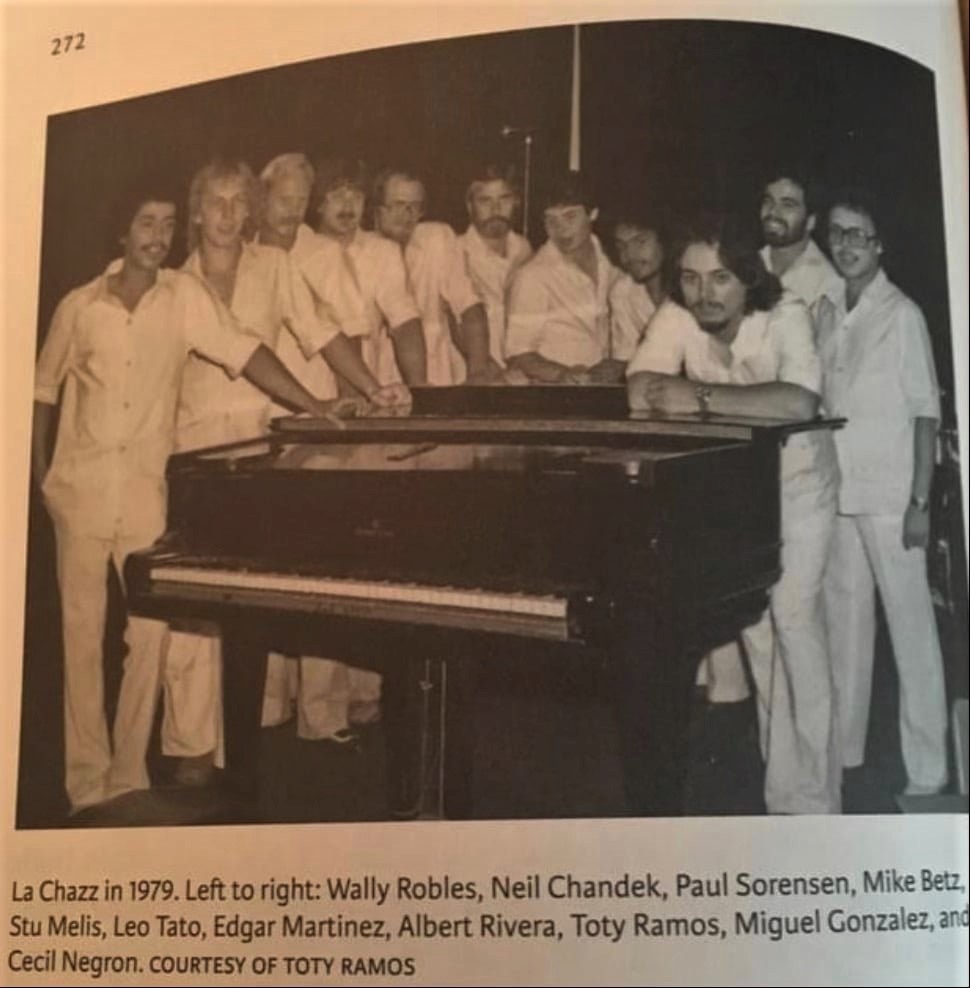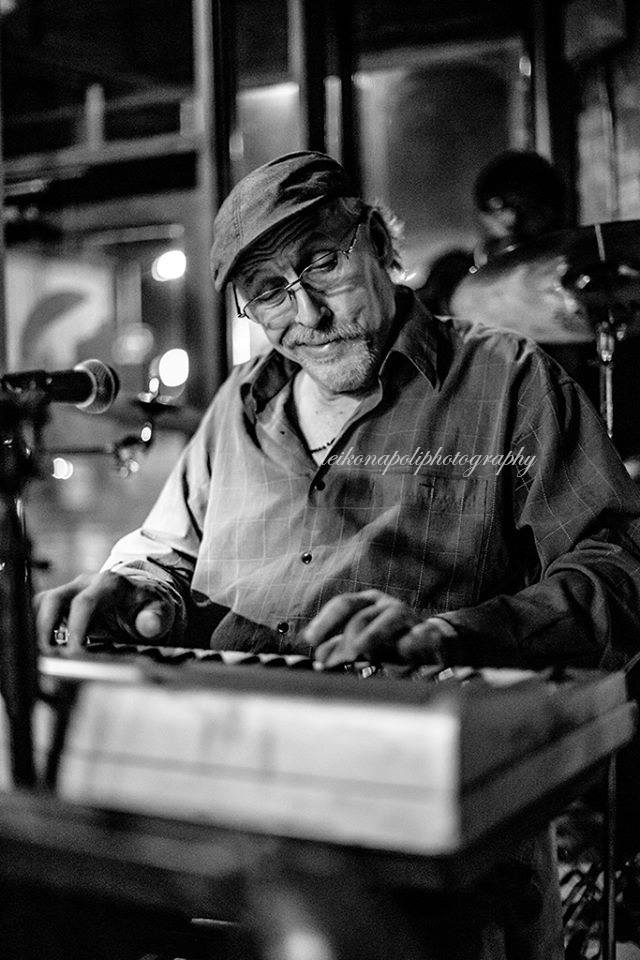
J6anuar0Syn968 29 5soiat 1l51dg77:432 AMl
Shared with Facebook Public
January 29, 2022, 11:45 a.m.
Had a marvelous, stimulating nearly 3-hour visit yesterday with my old friend (and former upstairs duplex neighbor), jazz musician Neal Chandek, who is in St. Mary’s hospital with a bad respiratory condition. He’s one of the most vibrant, knowledgeable and intelligent persons I know, and was in top form yesterday, aside from still being very dependent on induced oxygen, which he’ll need to continue with when he leaves. Thankfully now, he can periodically remove the full face mask to visit with friends (see photo). So please do so, he craves company.
***
“Descanse en Paz Amigo RIP” — guitarist Javier Mendez, in a farewell message to Neal Chandek
This death is devastating for me, the first personal friend of mine to die of complications of Covid. But I can only imagine what it means for the fellow musicians who were closest to him, and to family members.
Neal Chandek once dwelled near the heart of a booming Milwaukee jazz subculture, then for too long, in the shadows of even modest personal success – ever vital, yet a poor man in earthly goods. I suspect he even went hungry too often And yet, what comes to mind is a quote from a film he might’ve “died for,” Babette’s Feast – “An artist is never poor.”
The notion serves up as mostly cold comfort to me today and yet, deep down, in the vast and sprawling feast-and-famine of life, I feel the warmth of this man’s heart, and the radiant energy of his creative intellect, and hunger for knowledge, beauty, and truth.
Yes, my still-warm and even pulsing memories of him center upon that wonderful afternoon in late January. This deeply-stricken keyboardist and somewhat-forgotten trumpeter had asked me to visit him, and to lend him a book, a biography or autobiography, he said, to immerse himself in, I think. to assuage, and perhaps find meaning for, his suffering.
So, I lent him my copy of Miles Davis, a biography by Ian Carr, a noted British jazz writer and trumpeter. Yet, when I spoke to him for the last time, by phone a few days later, sadly, this voracious reader and maven of jazz and history, could only tell me to come retrieve the book. He feared it might get lost when he is soon transferred. I never made it back in time.
I think he was also pondering a lifetime, his own, and perhaps how it might take the form of a biography, even if it is never quite written. But I hope it is inscribed somehow, on the stone beneath which he might lie, or in the wind of his ashes, even if only a musical sequence of dark marks dancing in the currents that eventually carry him to a higher ground.
My mind traces him with such a notion because, among the remarkable things we touched upon in that deeply-gratifying last conversation – mostly driven by his own desperate need to seize the day, a rare heathy one – was of a higher power.
As we talked, he delved into a profound justification for such a truth, by deftly exposing what he saw as the castle-on-a-cloud constructions of certain neo-atheist theorists, like Richard Dawkins.
I can’t do justice to how surgically he stitched together the underlying truth, as so much is implicitly understood, even hermetically sealed, yet so righteous, a perfectly resolved harmony of the spheres. His thoughts aligned beautifully with that which I carry within me, as a sort of spiritual ballast. I explained to him, I’m an agnostic who spends an inordinate amount of time searching, believing in something, even in the unprovable, which often seems to me so manifest that even The Greatest Silence resounds wordless in The Song of the Wind.
This admission of mine came as a great relief to him as, for some reason, he assumed I was an atheist. I now hang onto this harmonized exchange as a small reward of solace we shared, for him most preciously – for most persons encounter fears of the empirically unknown, while beginning to face mortality’s cruel countdown.
He also urged me to read the great lay theologian C.S. Lewis, who seemed a touchsone for Neal, and I plan on it, probably his Mere Christianity and The Problem of Pain, for starters, as I’ve read more about Lewis than his actual work, except as a adolescent, the children’s classic The Lion, The Witch and the Wardrobe. I also will follow his urging to see the apparently extraordinary Nazi-era film Mephisto, an adaptation of the story of Doctor Faustus. And if I feel up to it, a book called Military Justice is to Justice what Military Music is to Music, a book by Robert Sherrill, with a title employing a Groucho Marx quote.
In those final 40-plus hospital-imprisoned days, the two-headed monster of COVID-19 and COPD pneumonia seared and ravaged his lungs. His pain and angst grew, until finally he could only reach out through social media with beckoning for prayers, the most genuine anyone could muster:
Neal Chandek Facebook Feb. 10, 11:52 a.m.
“Well, here I sit/lay. 34th day at St.Mary’s Hospital. Covid has scarred my lungs so badly that my body won’t absorb any oxygen. They’re not optimistic. I need your prayers. REAL PRAYERS!
READ MATTHEW 6/5 and you’ll know what I mean.”
Here’s Matthew 6/5 and 6/6, from The King James version:
6:5 And when thou prayest though shalt not be as the hypocrites are: for they love to pray standing in the synagogues and in the corners of the streets, that they may be seen of men. Verily I say unto you, they have their reward.
6:6 But thou, when thou prayest, enter into thy closet, and when thou hast shut thy door, pray to thy Father which is in secret; and thy Father which seeth in secret shall reward thee openly.

You, Jill Jensen, Kaye Berigan and 197 others
210 Comments
1 Share
Care
Doubters, especially now, may reasonably question whether those “secret prayers” were “rewarded.” For sure, Neal clearly loved and cherished life, as a song in the wind he needed to draw from as long as possible. Might some measure of faith allow us to surmise that, by invoking the sacred Biblical wisdoms, Neal began gulping in a long breath of grace? Something to bellow his spirit upwards, and beyond?
The bellow would be the baying of his own trumpet, too-long forsaken, but essential to the musician he was.

Neal Chandek (right, on trumpet) with Bembe Orchestra, at Marcus Center for the Performing Arts, Rainbow Summer, 1994. Pictured also, Alan Johnson, (left, on trumpet), Carlos Eguis Aguila, (center, on Bata drum – Okonkolo). Photo by Pat A Robinson.
I am deeply grateful that many friends have already honored him with spiritual salutations of many sorts on his Facebook page. In his last days, he surely had joyous memories of his 60th birthday celebration at Transfer Pizzeria Cafe, where a fulsome variety of friends, fans and well-wishers gathered that evening to hear him play with the Transfer Pizzeria Band, which he led there for more than a decade.
My oldest memories of Neal are of far-more-distant happy days in Milwaukee, when he lived upstairs from me on Astor Street, with fellow musician John Foshager. This was the mid-1980s, when I was covering jazz for The Milwaukee Journal, and he was playing piano and trumpet with La Chazz. That was a marvelous Latin-jazz group led by guitarist Toty Ramos. So Neal and I hit it off, with common interests extending even beyond the grand cavalcade of music of The African Diaspora.
I find it significant that, in the photo below of La Chazz, the band is gathered around a grand piano. That’s the instrument that Neal (second from left, in the photo) played and, as his very first Facebook honorific writer, Michael Reyes, recalls, Neil the pianist “could play a solid montuno, (and) he would often double on trumpet in the same ensemble.”

Image of La Chazz Courtesy of Cecil Negron Sr.
I’ll continue with a copy of Michael’s excellent memorial tribute to Neal:
Michael Reyes
Facebook
Tuesday, February 15, 5:42 p.m.
A monumental figure in the history of Milwaukee’s jazz scene has left us today at age 66. Neal Chandek was a trumpeter, pianist, arranger, educator, historian and provocative devotee of jazz, blues, latin jazz, salsa, son, rumba and beyond. Neal’s work with the groundbreaking Wisconsin-based supergroup “La Chazz” was nothing short of inspirational. A pianist, who could play a solid montuno, he would often double on trumpet in the same ensemble.
He dedicated his life to the music he loved. An alumnus of the Wisconsin Conservatory of Music and the University of Wisconsin-Whitewater, Neal was part of a contemporary group of virtuoso musicians that included Jeff Pietrangelo (trumpet legend), Brian Lynch, David Hazeltine, Jeff Chambers, Carl Allen, Toty Ramos, Cecil Negron, Walter “Wally” Robles, Albert Rivera, Jerry Grillo, Dennis Fermenich, Bill Martin and many others.
Neal’s commitment to music was 24/7. He would practice, teach, study, perform, rehearse and then read and reflect and meditate on music as much as his mind and body would physically allow him. He loved music of the African Diaspora as well as European Classical Music.
During the late ’70’s through the ‘80’s , Neal would often invite musicians to his home for after-hours listening parties (and jam sessions) that would extend past sunrise. Neal’s former room-mate, Grammy-winning jazz trumpeter Brian Lynch, composed and recorded a song entitled “Chandek’s Den” in 1989 memorializing those moments on his album “Backroom Blues” (Criss Cross Jazz 1042CD). Legendary Drummer Art Blakey also included “Chandek’s Den” in his final album “Chippin In” (Timeless) in 1990.
After a period of wide ranging musical freelancing, he started to give lessons on a larger scale. Thanks to musician and business owner Russell Rossetto, Neal began to enjoy the blessing of a steady weekly gig as leader of the Neal Chandek Trio at Milwaukee’s Transfer Pizzeria.
There he would hold court before excited audiences who often were treated to special musical guests who would sit in. Some of those guests included members of the Milwaukee Symphony Orchestra, as well as local, regional and national musicians who would stop by to say hi. Neal also invited young students to sit in to get experience.
Condolences to Neal’s sister Jane Prentice and her family. Sympathies go out to all of Neal’s friends, family, students, bandmates and loved ones.
Farewell Big Brother Neal Chandek RIP (b. 6-30-1955 d. 2-15-2022)

Neal Chandek. Photo by Leiko Napoli
I’ll conclude with a few final thoughts on Neal the man, the artist, and the jazz communitarian, partly inspired by this delightful photo (above) of Neal by noted Milwaukee jazz photographer Leiko Napoli. I think she captures the mature Neal Chandek’s personality as well as any photo that I’ve seen.
The man had a huge heart and a huge mind. The heart I hope to characterize by one more anecdote of my last visit with him on January 29. He was talking very hopefully and boldly as we were discussing common interests. He discovered that I, like him, am a golfer, and we compared notes on local golf courses and agreed that we should play a round as soon as the weather permitted. How much of this was wishful thinking, I wondered, given his state of possibly a chronic deficiency of oxygen, if somehow his lungs could recover. I had heard he was even a candidate for a lung transplant.
Another subject he brought up was gospel music, and he asked if I would be interested in going to a church service with a powerful gospel choir. It’s something I’ve wanted to do for a long time, and I enthusiastically said yes. As it is, perhaps I will hear a gospel choir some time which will bring me a little closer to Neal, and what I fancy to be his archangel’s trumpet.
And then, as we were talking about gospel singing he let loose with a few bars of resounding gospel-like soul singing of his own. I’ve heard a recording of him singing “Georgia on My Mind.” So I knew what he could do with his voice, but I was stunned that he could even belt out a few bars in his oxygen-compromised condition.
Yes, he was a little larger-than-life nearing death, on that afternoon. As the photo above suggests, he had an impish wit and intellect.
He could discourse on any number of subjects of historical or cultural significance. Sometimes, when he was really cooking, his flow of ideas and opinions could get a bit overbearing. But I think he was conscious of that, and during our conversation he frequently pulled himself back, to hear my response. I, of course, wanted to feed him all the intellectual oxygen he could ingest, to transform into golden moments of give-and-take.
I have one last anecdote about Neal, the jazz-jam maestro, which is part of my forthcoming (I swear!) book Voices in the River: The Jazz Message to Democracy. I will save it for the publication of the book. Neal knows the story very well, and it demonstrates how his ability to connect with, and gather, musicians extended to some of the most celebrated jazz players who ever visited Milwaukee in the 1980s and early-1990s, a heyday of jazz in this city.
Descanse en Paz Amigo RIP.
____________

